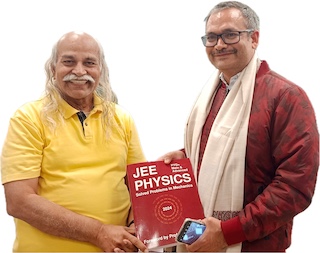Capacitance
A capacitor store electrical energy by storing charge on two conductive plates separated by a dielectric material. The capacitance of a capacitor is a measure of its ability to store electrical charge. It is defined as the ratio of the amount of charge Q stored on each plate to the voltage difference V between the plates i.e., \begin{align} C = \frac{Q}{V}. \end{align} The unit of capacitance is Farad. The capacitance is proportional to the area of the plates and inversely proportional to the distance between them. The dielectric material with higher dielectric constant results in a higher capacitance.
Spherical Capacitor
A spherical capacitor is made from two concentric shells. The radius of the inner shell is $a$ and it carries a charge $+Q$. The radius of the outer shell is $b$ and it carries a charge $-Q$. The capacitance of the spherical capacitor is given by \begin{align} C=\frac{4\pi\epsilon_0 ab}{b-a}. \end{align}
Cylindrical Capacitor
A cylindrical capacitor is made from two concentric cylinders, each of length $l$. The radius of the inner cylinder is $a$ and that of the outer cylinder is $b$. The capacitance of cylindrical capacitor is given by \begin{align} C=\frac{2\pi\epsilon_0 l}{\ln(b/a)}. \end{align}
Problems from IIT JEE
Problem (IIT JEE 1999): Two identical metal plates are given positive charges $ q_1 $ and $ q_2 $ $( < q_1)$ respectively. If they are now brought close together to form a parallel plate capacitor with capacitance $C$, the potential difference between them is,
- $\frac{q_1+q_2}{2C}$
- $\frac{q_1+q_2}{C}$
- $\frac{q_1-q_2}{C}$
- $\frac{q_1-q_2}{2C}$
Solution: Let $A$ be area of the plates and $d$ be separation between them.
The electric field in the region between plates due to the left plate is \begin{align} \vec{E}_1 &=\frac{\sigma_1}{2\epsilon_0}\,\hat\imath \\ &=\frac{q_1}{2\epsilon_0 A}\,\hat\imath, \nonumber \end{align} and due to the right plate is \begin{align} \vec{E}_2 &=-\frac{\sigma_2}{2\epsilon_0}\,\hat\imath \\ &=-\frac{q_2}{2\epsilon_0 A}\,\hat\imath. \nonumber \end{align} The resultant field $\vec{E}$ and potential difference between two plates are, \begin{align} \vec{E} &=\vec{E}_1+\vec{E}_2 \\ &=\frac{q_1-q_2}{2\epsilon_0 A}\,\hat\imath, \\ V &=Ed=\frac{q_1-q_2}{2(\epsilon_0 A/d)} \\ &=\frac{q_1-q_2}{2C}.\nonumber \end{align}
